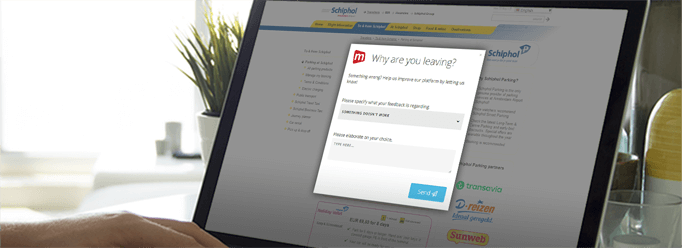More and more companies are making every effort to improve the (digital) customer experience. According to Forrester, in 2019 this market will increase to a value of $ 8 billion. The first step towards improvement begins with the collection of data. After all, you must avail of the necessary information first in order to comprehend what can be improved.
Where previously the primary focus was on quantitative data – for instance web analytics and A/B testing – nowadays mass amounts of online marketers are flirting with feedback tools placing themselves behind the buttons. This self-service approach has advantages and disadvantages for companies that want to work seriously with online customer feedback.
The advantages
1. Acquiring learnings
Let’s start with the benefits of such tools. In the first place, it is a quick and relatively inexpensive way to obtain online customer feedback learnings. Especially for organisations that do not have experience with online feedback this is a great way to experiment. You simply open an online account which many providers often provide with a free trial period or completely free (limited) use. Since the financial investment is not too high, you do not directly have to go approach procurement for a signature. In short, you can access the customer feedback and see what works for your organisation on the spot.
2. IT
After signing up for a free trial or licence the implementation of most tools is reasonably straightforward. Especially with the emergence of Tag Management Tools (such as Google Tag Manager) without the intervention of your IT colleagues you can insert a JavaScript into a page. Then using the tool itself you can designate the URLs for which you want to ask for feedback.

A few years ago, most marketers would get nervous about the idea that they had to involve the IT department. Fortunately modern tools are designed so that with an online manual you can get started. If you have queries, you can – depending on your licence – often approach a support team with your questions.
3. Press the button
Among marketers the main reason to use a self-service tool is that you can sit behind the controls yourself. Especially if SCRUM teams or impromptu campaign cycles are involved, then you want to act quickly. If a new feature or landing page goes live you want to collect insights in order to implement interim improvements.
The advantage of self-service tools is that you can directly activate a feedback form with an appropriate question. You do not need to approach a desk – which often results in extra costs – to submit a request. You yourself are in control so you can respond quickly to developments in the market and within the organisation.
Who is responsible
We live in a time where thanks to technology we as professionals can do more ourselves. This also entails a lot of responsibility. Within the context of this article you will be responsible for the voice of the digital customer, but is it smart that you bear this responsibility?
Here are a few disadvantages of self-service feedback tools.
The cons
1. Do not be a “fool with a tool”
Getting behind the controls yourself and determining which questions are asked, offers flexibility. On the other hand, as a marketer you are already incredibly busy and to what extent do you want to create feedback forms yourself? Let alone formulating which questions are going to be presented to customers that result in technically sound research. Especially the latter is something that is taken too lightly.
Feedback collection
If you want to collect usable, pure and valid data to improve the digital customer experience, then right from the start you have to have the right approach. This is where you can draw conclusions from relevant questions and rating scales. Forget for now the discussion about which metric you will use but comprehend where in your website for example you can ask a NPS® question.

The location of your feedback form on the site says something about the value of the answer. Relevant questions in a relevant place is a must for valuable insights.
One of the drawbacks of many self-service customer feedback tools is that it is mainly about the features. Unfortunately supervision, advice and expertise with regard to questions asked as well as valid data does not come with the package. In this respect, (online) research and digital customer experience is a discipline in its own right.
2. Data is not information
Another disadvantage of working with self-service feedback tools is the lack of analysis options. I think it is quite likely that you have to create Excel reports yourself because your feedback tool does not offer this option. You’re not alone in this respect. The reason is quite simple: feedback tools collect feedback. In this respect, their purpose is clear, but what good is that to you?
Focus on insights
Data is a commodity. Which marketer does not experience an overload of data? The essence is obtaining information from data but most feedback tools are limited to an inbox and sometimes pre-defined metrics. Yes, you will save time and money in the short term when you are sitting behind the controls. Unfortunately, in the long term it will cost you much more time and money in order to extract useful insights from the available data.
Reporting capabilities
There are also smart systems in the market that do offer reporting capabilities for online customer feedback. However, in this scenario you do not get to sit behind the controls so quickly yourself because a supplier cannot guarantee the quality of your data. In addition, you must consider that proper analysis software is often in a slightly different price range than a feedback collection tool. It is up to you to choose what is important: more extensive capabilities in analysis and reporting or getting behind the buttons yourself in order to create a feedback form.
3. Feedback is not a toy
Self-service feedback tools provide much playfulness around the theme of customer feedback. One week you ask customers for feedback, the other week you quit because it does not deliver what you expected. It is important to realise that customer feedback is a service to improve the customer experience (CX). It is not a marketing toy that you can take out of the box when it suits you. Impromptu requests for feedback creates a fragmented picture of the online customer.
Silo’s
In many organisations customer experience is housed with a multidisciplinary team consisting amongst others of marketing intelligence and customer service. Now that customers make more use of online services you want to know what they think of the site as far as usability is concerned. At the same time the CX team has wider organisational needs and for example want to pose their transactional NPS® on the website. Other interests, other needs, but ultimately you both have the same goal: to improve the customer experience. This is a structural goal and not an impromptu project with a beginning and an end.

The playfulness of self-service feedback tools is too often expanded into customer feedback with the result that it is seen as something without consequences or independent of a broader customer experience strategy.
Want to learn more about Mopinion’s all-in-1 user feedback platform? Don’t be shy and take our software for a spin! Do you prefer it a bit more personal? Just book a demo. One of our feedback pro’s will guide you through the software and answer any questions you may have.
Free trials
Cheap licences and free trials are tempting to quickly try out a feedback tool and are a good starting point to begin collecting feedback on the website. As I said this has advantages, but every advantage has its disadvantage. If you want to seriously get started with customer feedback: determine in advance what you want to achieve with it and check internally what that means for your organization.
Ready to see Mopinion in action?







